Vagrant Species Part 1
Issue date: 19th November 2019
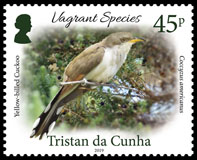 |
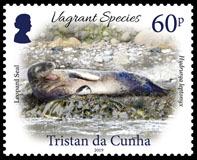 |
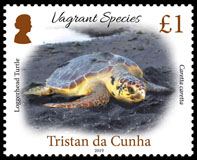 |
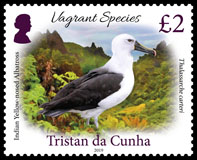 |
| 201909 | Mint Stamps (45p, 60p, £1.00, £2.00) | £4.05 |
| 201910 | First Day Cover (with 45p, 60p, £1.00, £2.00 stamps) | £5.05 |
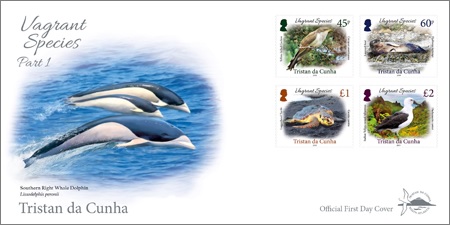
Tristan da Cunha lies in the middle of the South Atlantic Ocean, east of the mid-Atlantic ridge, 2,800km from the continental shores South Africa, and 3,360km from South America. It is the most remote island in the world with a resident human population, with St. Helena, the nearest island some 2,400km away. Vagrant species might seem to be a curiosity, but all of the native animals on Tristan arose from individuals that wandered far from their usual haunts.
45p - Yellow-billed Cuckoo (Coccyzus americanus) - breeds throughout eastern North America, in southeast Canada, northern Mexico and the Greater Antilles, migrating to South America (Peru, Bolivia and northern Argentina) in the northern winter. Unlike the cuckoos in the Old World, they build their own nests and rear their own young.
Found on Tristan da Cunha in November 2015, the cuckoo could have been a ship-assisted vagrant, as more than 2600 vessels pass through Tristan's waters annually, but prevailing winds on the islands are north-west, which bring vagrant birds from South America. The cuckoo arrived the day following a large frontal system moved west to east. This record is the first for this species in the Southern Hemisphere outside South Americas and it is now in the collection of the Natural History Museum (Alex Bond).
60p - Leopard Seal (Hydrurga leptonyx) - is the second largest species of seal that breeds in the Antarctic pack ice, and renowned for its predatory behaviour, eating penguins and young seals as well as squid, fish and krill. Some individuals wander farther north, mainly in winter.
The first recorded visit to Tristan da Cunha was in September 2016 and then another in July 2019 after a severe storm. Only two records exist from Gough Island situated 360km to the SW of Tristan da Cunha Island, in the central South Atlantic Ocean (Marthan Bester).
£1 - Loggerhead Turtle (Caretta caretta) - commonly called "loggerhead" sea turtles due to their overly large heads with a horny beak that is significantly thicker than in other sea turtles. This species is the largest hard-shelled turtle in the world. They are found in coastal tropical and subtropical waters often extending to temperate waters in search of food.
Loggerhead Turtles breed at beaches in Brazil and locally along the coast of West Africa, and disperse widely at sea throughout the South Atlantic Ocean. Discovered on the beach west of Calshot Harbour, Tristan da Cunha, in May 2008.
£2 - Indian yellow-nosed albatross (Thalassarche carteri) - this close relative of the Tristan 'Molly' breeds on the Southern Indian Ocean Islands of Prince Edward, Crozet, Kerguelen, Amsterdam and St Paul. When feeding during incubation, birds will forage up to 1,500km (930 miles) from the colony. At sea, it ranges from South Africa to the Pacific Ocean just beyond New Zealand.
The first confirmed sighting on land was a bird that landed on Gough Island in January 2019. Prior to that a few birds had been spotted at sea around Tristan da Cunha in summer.
FDC - Southern Right Whale Dolphin (Lissodelphis peronii) - a spectacular species of marine mammal found in cool waters of the Southern Hemisphere; this is one of the least known dolphin species.
About 70 were spotted between Tristan and Nightingale in September 2014 from aboard the SA Agulhas II, and there are two other records from within the Tristan EEZ. Easy to identify with their striking coloration, extremely long, slender bodies and no dorsal fin, it is thus likely that they are genuinely scarce visitors to Tristan waters.
Technical Specifications from Pobjoy Mint Ltd.
| Designer: | Andrew Robinson | Stamp size: | 30.6 x 38mm |
| Printer: | Cartor Security Printing | Perforation: | 13¼ x 13 per 2cms |
| Process: | Stochastic Lithography | Layout: | 10 |
| Production Co-ordination: | Creative Direction (Worldwide) Ltd |
